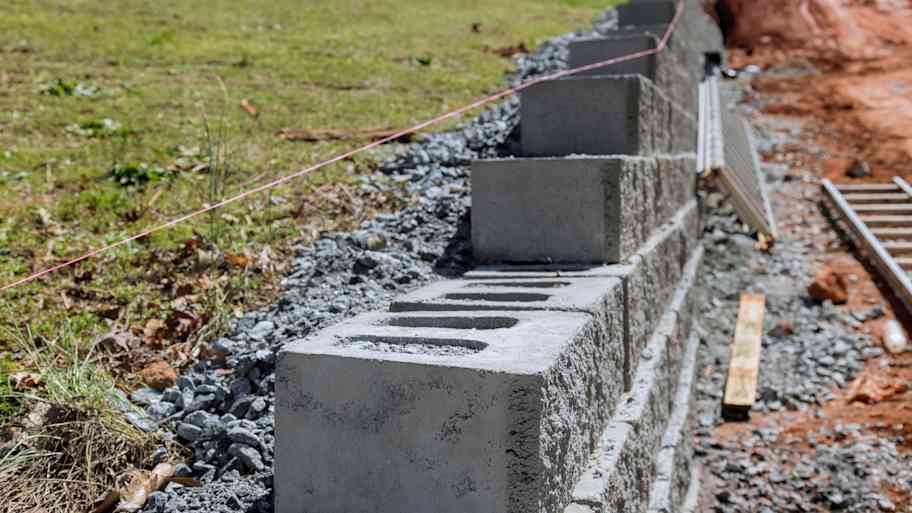
Discover how much wrought iron fence installation costs depending on factors like its size, thickness, design, and location.
With a little math, you can make your yard the most stylish one on the block


Not sure how to calculate blocks for a retaining wall? You can determine it using a formula.
To use the formula, you’ll need to know the height and length of your retaining wall.
You should also know the height and width of the blocks you plan to use.
It’s a good idea to buy extra blocks to account for breakage, waste, and future repairs.
For a 3-foot-high, 30-foot-long wall, you’d need 310 blocks (including a 10% overage).
Retaining walls might look like simple structures, but there’s quite a bit that goes into designing and building them. If you plan to tackle this project yourself, part of the process involves learning how to calculate the blocks for your retaining wall. Here’s how it works.
When deciding how many blocks to use in your retaining wall, you’ll need to know the dimensions of each block, as well as the height and length of your wall. We’ll explain how to calculate this later.
For now, let’s look at how many blocks you’d need for a 3-foot-high retaining wall in different lengths, assuming you use 4-by-11.75-inch blocks (a standard size). It also includes an extra 10% to account for breakage and cutting.
| Retaining Wall Length (in Linear Feet) | Retaining Wall Area (in Square Face Feet) | Number of Blocks |
|---|---|---|
| 10 | 30 | 104 |
| 20 | 60 | 207 |
| 30 | 90 | 310 |
| 40 | 120 | 414 |
| 50 | 150 | 517 |
| 60 | 180 | 620 |
| 70 | 210 | 724 |
| 80 | 240 | 827 |
| 90 | 270 | 930 |
| 100 | 300 | 1,034 |
When designing your retaining wall, you’ll need to decide on a height and length. From there, you’ll multiply the height and length to get the square face footage of the wall (the square feet of the wall’s face).
You’ll also have to decide which size blocks to use. Retaining wall blocks come in various sizes, typically ranging from 3 to 8 inches in height and 11 to 18 inches in width. When you have these dimensions, you’ll multiply them to get the square face footage (or the square feet of each block’s face). For example, if your blocks are 4 inches high and 11.75 inches wide, each block is 0.319 square face feet.
When you have these numbers, you can plug them into this formula:
Number of Blocks Needed = (Retaining Wall Area in Square Face Feet / Square Face Feet per Block) x 1.1
For example, if you’re building a retaining wall that’s 3 feet high and 30 feet long, its square face area would be 90 square feet. If you use 4-by-11.75-inch blocks (each of which is 0.319 square face feet) and plan for 10% overage, you’d need 310 blocks.

During the planning phase of this hardscaping project, use a tape measure to determine the optimal height and length for your retaining wall.
These dimensions will depend on several factors, including the size of your space, the type of retaining wall, and the wall's intended purpose. Generally speaking, though, retaining walls built with blocks shouldn’t be taller than 4 feet due to the heavy weight of the material.
If you need help choosing the size of your wall or your blocks, reach out to a retaining wall installer near you.
Whether your goal is to prevent erosion, improve drainage, or enhance the appearance of your yard, consider hiring a professional to build your retaining wall. You’ll pay between $15 and $50 per square foot for their services, which equates to $1,350 to $4,500 for a 3-foot-high, 30-foot-long wall. However, it’s usually worth the investment—here’s why.
For one, this is a job that requires construction experience, landscaping knowledge, and a serious amount of heavy lifting. Plus, if your wall is over a certain height, you’ll also need to get a permit and consult a local structural engineer. It’s much easier to leave all of these things to a professional.
From average costs to expert advice, get all the answers you need to get your job done.

Discover how much wrought iron fence installation costs depending on factors like its size, thickness, design, and location.

Explore the key factors that impact vinyl fence installation costs in Columbus, OH, including labor, materials, permits, layout, design, and yard conditions.

Pool fence costs depend on the type of fencing and the size of your pool. This guide will help you figure out the true cost of pool fence installation.

Determining whether to repair or replace fence installations can be a difficult choice. Learn more about what factors can help you decide which way to go.

Whether you’re looking to replace your chain link fence or just want it gone, find out how to remove a chain link fence here.

Moisture is often to blame for warped fence panels—but there are other causes, too. Learn about the most common ones (and how to fix them) in this guide.